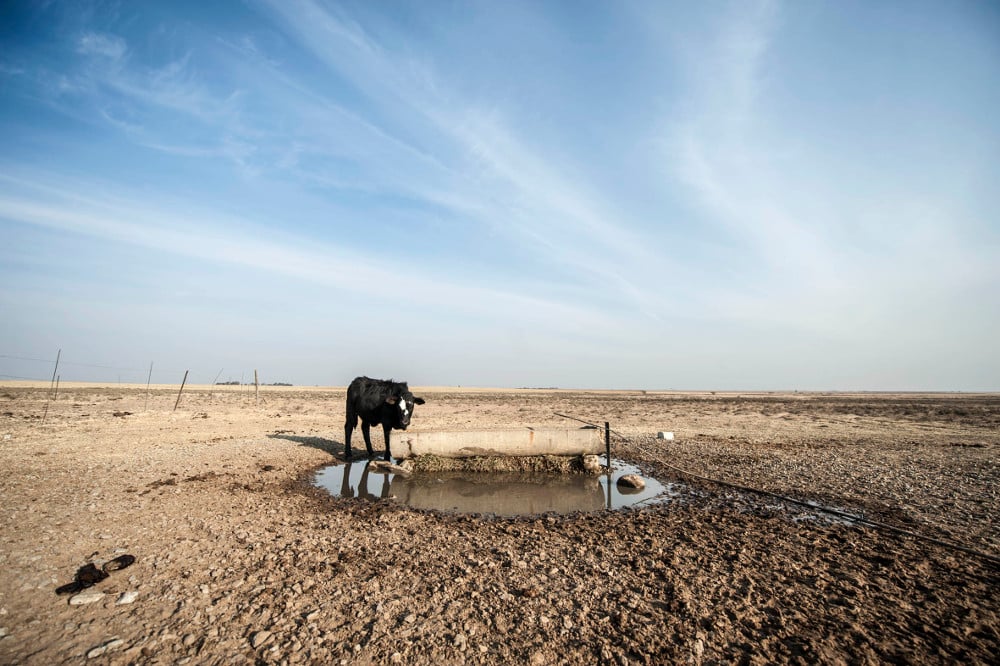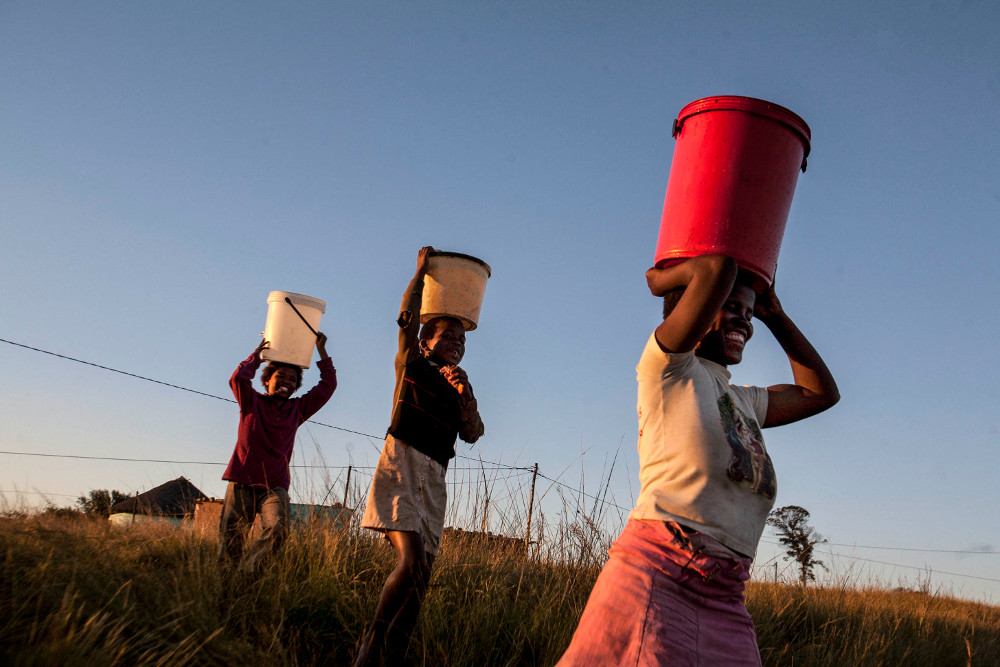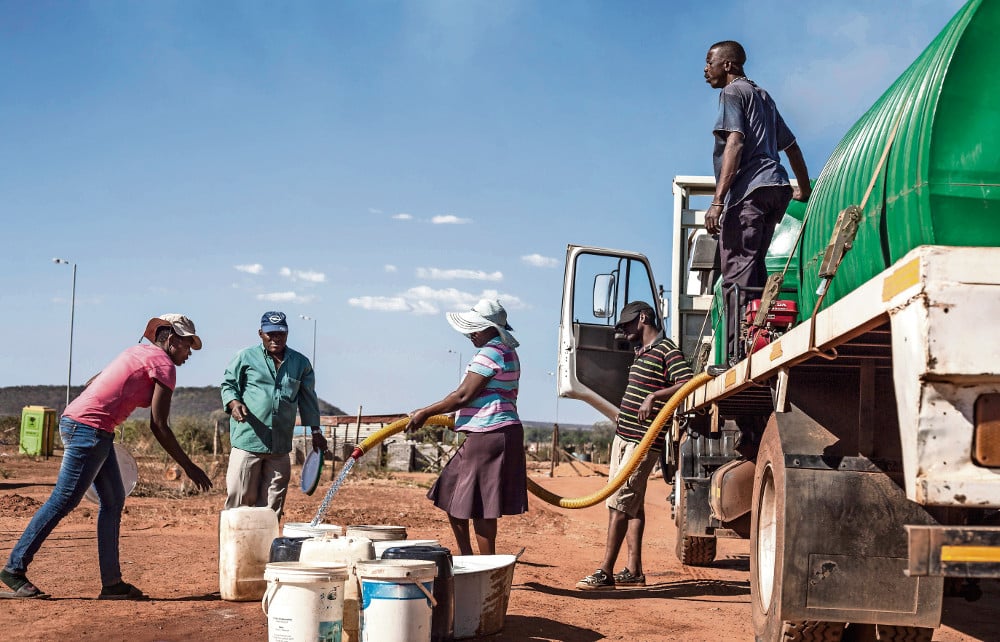In the corridors of the offices of the department of water affairs in Pretoria the atmosphere is “verging on panic”, insiders say. The rains have failed for the first time since 1994, and the carefully laid plans for such a disaster have been implemented patchily, where they were implemented at all.
At least a decade ago the department knew the rains would dry up.
El Niño – a weather phenomenon that rapidly heats the Pacific and brings drought to the southern hemisphere – is a fairly regular occurrence. But the department has been crippled by a regular turnover of skilled staff – five acting and permanent director generals have come and gone in the past five years. It has also had to partner with other departments – forestry, sanitation and environment – which has seen a churn in skills.
That triumph of politicians over technocrats has left the country responding to a water crisis, rather than pre-empting it.
If just 25mm of rain falls soon it would take the worst strain off the water system and get farmers planting, which should push the crisis back at least one more season. But even that seems too much to ask, according to the best available weather predictions. If those rains do not come, well, nobody likes to think about what happens then.
South Africa is an arid country. It receives an average of 450mm of rainfall each year, half the world average. In the past, droughts, though they hurt, were overcome through engineering on a heroic scale applied to a population smaller than that of today. This time around, however, entire provinces are in crisis because a skills shortage and lack of political continuity has left the country responding to the disaster with calls for prayer.
No amount of clever politics or good administration could have averted the drought, just about everyone agrees, but the effect of it could have been softened. Instead, it has been intensified.

The agriculture department is pushing for a reduction of herd sizes in drought-stricken areas. (Delwyn Verasamy, M&G)
To overcome the crisis, it must rain in the next five weeks. But it won’t. The cracks will widen as the earth crumbles further in the breadbasket provinces. Once green fields will complete their transformation to Karoo wilderness. People will run out of water and staple foods will become less affordable.
And there will be hard questions to ask before the next meaningful rain, now expected in March next year.
With most of the country’s rain falling in the east (thanks to the warm Indian Ocean), the water system is highly dependent on dams and pumping water uphill to get it to the interior. Lesotho was strong-armed into turning itself into a dam for Gauteng’s industry and irrigation in the Free State and Mpumalanga; the Katse Dam in that country is all that stands between Gauteng and serious thirst.
This system got South Africa through the last two devastating droughts, in 1983 and 1992, even though they crippled the economy and agriculture.
But those droughts were in a country of 39-million people and a much smaller industrial base. The number of people has grown by more than a third, but the quantity of available water has shrunk. Now each South African gets about 1 000m3 of water a year.
In the next five years, the 2030 Water Resources Group predicts, there will be a water shortfall of 17%. All of these facts are included in the government’s long-term water scenarios.
“Regular drought and El Niño spikes are a fact in South Africa. You plan for them in your 100-year building plans,” says a former department of water and sanitation official.
El Niño was overdue by a decade, which should have given planners breathing space, the official says. “The problem with plans is you have political upheaval and that brings a broom. Everything stops.”

The water department was recently given its own minister after a period when it fell under the environment minister.
It has consistently been given qualified audits, and in the last year underspent on its budget by R2-billion. Lack of capacity and skills have meant the department – and municipalities – do not spend the money they are given for development. Where there is development, it is top-down and excludes communities, so projects fall apart when government leaves.
Three officials working for the water department confirm that, although there were long-standing plans on how to mitigate the effect of a national drought, these did not get the attention they needed.
“We didn’t ignore this or plan to fail, we just screwed up. We dropped the ball,” says one of the three. “There should have been a much stronger campaign to stop leaks, stop people wasting water and to really work on industry and the agricultural sector to use water more efficiently.”
This would have ensured that more water was stored in South Africa’s dams – particularly the five mega-dams that carry most of the country’s water, they say. “What we did instead was pay lip service to water saving and only got serious when the crisis was too late to avert.”
The water department has now woken up to the need to push rapidly for people to conserve water, but only after the problem stopped being one in far-flung provinces and became urban. Last week Rand Water declared water restrictions in Gauteng.
Speaking during a media blitz this week, Minister Nomvula Mokonyane said: “The most important thing is for South Africans to understand that we are a water-scarce country.”
Her department has called for prayer, and blamed a whole host of different sectors for not doing enough to conserve water, but it did not respond to the Mail & Guardian’s questions.
Rand Water’s announcement of restrictions gives an insight into the dual problem: Water had to be restricted because increased demand was putting too much stress on infrastructure, it said. The actual availability of the water itself was only a secondary concern.

About 6 500 communities are facing water shortages. (Oupa Nkosi, M&G)
These two issues bedevil water provision nationwide. At a town level, municipalities are tasked with providing water to their residents. But data from the Water Research Commission shows that up to half of this water leaks away, because of dilapidated infrastructure and poorly built replacement infrastructure. At a national level, dams are built behind schedule: the De Hoop Dam in Limpopo was half a decade late, and the critical next phase of the Lesotho Highlands Project is at least three years behind schedule. These dams are meant to store enough water to bridge the gap between supply and demand in times of water scarcity.
Lack of storage has hit KwaZulu-Natal first, and hardest. The province is going through the driest period in recorded history. About 150 000 people are receiving disaster aid in the form of water and food parcels. More than 40 000 head of cattle have died.
Two doctors in the province told the M&G that medical procedures were being postponed because of a water shortage. A doctor in Limpopo said the same was happening there.
The running tally of communities facing critical water shortages, from previous infrastructure failure and now the drought, is at 6 500.
The hardest-hit provinces are also the country’s most important food production areas. Average profits in the agricultural sector are 3% – leaving little breathing room for farmers to survive an increase in the costs of production, or a drop in the value of their produce.
Both of these are happening.
Henk van de Graaf, a smallholder farmer in Cullinan in Gauteng and spokesperson of the Transvaal Agricultural Union, says farming nationally is struggling to survive a second season of drought. “You can start worrying about the food on your table because farmers are standing on a cliff.”
His allotment used to be fertile and have enough water until illegal mining started to destroy underground water sources. This is a story repeated throughout South Africa, with farmers complaining that long-term food and water security have been sacrificed for short-term gains in mineral extraction. Van de Graaf now has no water. “It’s like the Karoo,” he says. This results in inferior-quality produce, which translates to less value at the market.
Several cattle auctioneers say that an increasing number of livestock farmers are selling at close to a loss out of fear of losing their entire herds to the drought. The government has recommended this path, with the agriculture department pushing for a reduction of herd sizes in drought-stricken areas.
For maize and sorghum farmers – the country’s staple food – the first year of drought was nearly catastrophic. The yield dropped by a third. The country went from a net exporter of maize to an importer. At R3 300 a tonne, this maize was 10% pricier than local production. That added to the deficit in the country’s balance of payments with foreign currency needed to buy the grain.

Cullinan is feeling the lack of water. (Delwyn Verasamy, M&G)
The World Food Programme has warned that this will be further exacerbated by a second year of “uncharacteristically low” rainfall, with “significant drops in crop production”.
In an earlier report, the United Nation’s climate change agency gave a general warning that short-term shocks from rapid changes in climate will put pressure on already weak social and governance structures, and possibly provide catalysts for outbreaks of civil unrest.
Syria’s revolution is thought to have been driven by the country facing the worst drought in recorded history, which drove farmers into the cities and added enough pressure to incite revolution.
The immediate future will probably not produce anything so dramatic, says the recent Parched Prospects report by the Institute of Security Studies. Instead, the current drought gives an indication of what a future with increasingly scarce water supplies will look like, the report says.
The infrastructure problem is going to cost R700-billion by government estimates but the issue of scarcity will never go away, the report says. The test from now is whether or not government has the structures and resilience to really manage this.
Like others, the report likens the water crisis to what happened in power production – an undervalued commodity encouraging little saving, and little attention paid to infrastructure, leading to a collapse in service delivery.
The report says the problems are structural in government, so the scarcity of engineering capacity and the excess of political interference in water management need to be solved before long-term security can be found. The report is hopeful when it comes to the “where to next?” question – like many others.
One farmer says: “We are naturally hopeful: you wake up each morning and look at the clear blue sky and think it will rain. You have to.”
The farmers subscribe to a whole host of weather services but they give a far less optimistic outlook. The South African Weather Service’s warning is bleak: “The likelihood of the country experiencing consistently dry and hot conditions toward the summer season remains high.”
But any form of recovery could be limited, even if the rain does come in March next year. Each El Niño is normally followed by a La Niña. This rapidly cools the Pacific and leads to heavy rains in Southern Africa. That rain will fill dams, but it is often so heavy that it washes away topsoil and damages vegetation. This would mean a third year of interrupted crop production.
It’s not a crisis, says ministry
- “These are not water cuts but they are water restrictions … So perhaps to call it a crisis at this stage will be putting the cart before the horse.” – Water affairs spokesperson Mlimandlela Ndamase, in November 2015
- “We will never ever have a situation of water-shedding. It will never happen.” – Water Minister Nomvula Mokonyane, in an eNCA interview, November 2015
- “Let me remind you that we have a responsibility to save water. All of us. When you see a leaking tap, close it. When you see a leaking pipe on the road, inform the authorities. Nobody should waste water. It is very scarce and we could find ourselves in difficulties if we do not act now to save water.” – President Jacob Zuma, launching the War on Leaks Project, in August 2015
The future is dry and hot
El Niño is a regular phenomenon – named after the Christ Child because it appears seasonally, around Christmas time – and has been identified as the cause of famines for centuries. In the 1700s it was linked to crop failures, which led to the circumstances that drove the French Revolution.
Nasa has warned that a warming world will make El Niño considerably worse, because the majority of warming is stored in the world’s oceans.
Regardless of El Niño, South Africa’s water scarcity will become more acute. Predictions collated by the environment department show that by 2050 the interior will be on average 3°C hotter. By 2100, it will be 5°C hotter. This will mean less rain in the west and more in the east. But this rain will come in shorter and heavier spells – damaging top soil and crops.
Whose water is it?
By law, the department of water affairs owns all of South Africa’s water, which it provides to municipalities and utilities such as Rand Water. These then pipe it to households. But up to half the water put into pipes is lost through leaks before it reaches the end user.
At the other end of the water system, sewage treatment plants work above their build capacity and, according to the last Green Drop report, often release raw sewage into dams and rivers.
The natural systems that would help fix this problem, such as wetlands, have been so heavily damaged that the rivers are 80% polluted.
This flows into the dams that store drinking water – such as the Vaal. More pollution makes the water harder to make drinkable; the last Blue Drop report says half the country’s water treatment plants are not cleaning water properly.